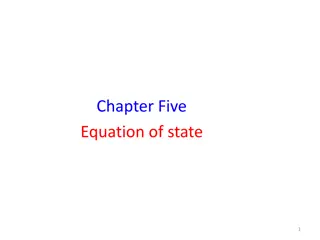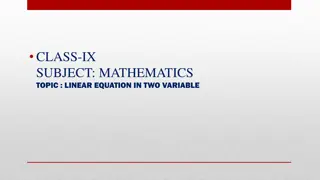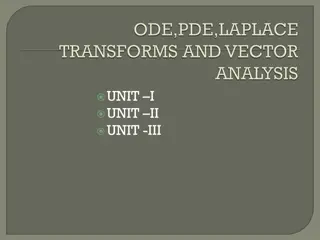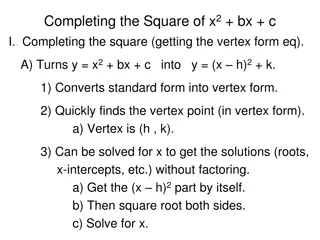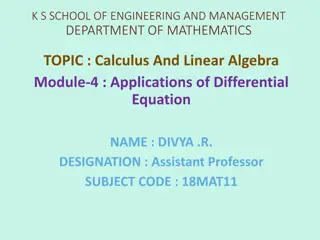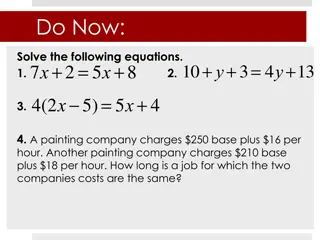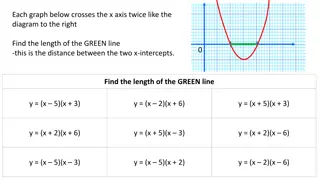
Symmetric Functions in Math
Learn about symmetric functions in mathematics, which are formal power series invariant under permutation of variables, and explore their applications in combinatorics and group theory. Discover how symmetric functions relate to counting unlabeled graphs and representations of linear groups.
Download Presentation

Please find below an Image/Link to download the presentation.
The content on the website is provided AS IS for your information and personal use only. It may not be sold, licensed, or shared on other websites without obtaining consent from the author. If you encounter any issues during the download, it is possible that the publisher has removed the file from their server.
You are allowed to download the files provided on this website for personal or commercial use, subject to the condition that they are used lawfully. All files are the property of their respective owners.
The content on the website is provided AS IS for your information and personal use only. It may not be sold, licensed, or shared on other websites without obtaining consent from the author.
E N D
Presentation Transcript
Click to add text SYMMETRIC FUNCTIONS CHAPTER 5
WHAT ARE SYMMETRIC FUNCTIONS? Symmetric functions are not functions. Symmetric functions are not functions. They are formal power series in the infinitely many variables x1, x2, . . . that are invariant under permutation of the subscripts.
In other words, if i1, . . . , im are distinct positive integers and 1, . . . , m are arbitrary nonnegative integers then the coefficient of x 1 i1 x m im in a symmetric function is the same as the coefficient of x 1 1 x m m . Examples: I x 2 1 + x 2 2 + . . . I P i j xixj But not P i j xix ^2 I Some combinatorial problems have symmetric function generating functions. For example, Q I I Symmetric functions are useful in counting plane partitions.
I Some combinatorial problems have symmetric function generating functions. For example, Q I Symmetric functions are closely related to representations of symmetric and general linear groups I Symmetric functions are useful in counting unlabeled graphs (P lya theory Let denote the ring of symmetric functions, and let n be the vector space of symmetric functions homogeneous of degree n. Then the dimension of n is p(n), the number of partitions of n. A partition of n is a weakly decreasing sequence of positive integers = ( 1, 2, . . . , k ) with sum n.
The ring of symmetric functions Let denote the ring of symmetric functions, and let n be the vector space of symmetric functions homogeneous of degree n. Then the dimension of n is p(n), the number of partitions of n. A partition of n is a weakly decreasing sequence of positive integers = ( 1, 2, . . . , k ) with sum n. For example, the partitions of 4 are (4),(3, 1),(2, 2),(2, 1, 1)and (1, 1, 1, 1). There are several important bases for n , all indexed by partitions
Monomial symmetric functions If a symmetric function has a term x 2 1 x2x3 with coefficient 1, then it must contain all terms of the form x 2 i xjxk , with i, j, and k distinct, with coefficient 1. If we add up all of these terms, we get the monomial symmetric function m(2,1,1) = Xx 2 i xjxk where the sum is over all distinct terms of the form x 2 i xjxk witMonomial symmetric functions If a symmetric function has a term x 2 1 x2x3 with I, j and k are distinct.
Monomial symmetric functions If a symmetric function has a term x 2 1 x2x3 with coefficient 1, then it must contain all terms of the form x 2 i xjxk , with i, j, and k distinct, with coefficient 1. If we add up all of these terms, we get the monomial symmetric function m(2,1,1) = Xx 2 i xjxk where the sum is over all distinct terms of the form x 2 i xjxk with i, j, and k distinct. So m(2,1,1) = x 2 1 x2x3 + x 2 3 x1x4 + x 2 1 x3x5 + .
We could write it more formally as X i6=j, i6=k, j More generally, for any partition = ( 1, . . . , k ), m is the sum of all distinct monomials of the form x 1 i1 x k ik . It s easy to see that {m } `nis a basis for n Multiplicative bases There are three important multiplicative bases for n . Suppose that for each n, un is a symmetric function homogeneous of degree n. Then for any partition = ( 1, . . . , k ), we may define u to be u 1 u k . If u1, u2, . . . are algebraically independent, then {u } `n will be a basis for n We define the nth elementary symmetric function en by en = X i1<
Functions have two main types of symmetry. If the function is even, its graph will be symmetric about the y-axis. If the function is odd, its graph will be symmetric with respect to the origin. Here, we will look at a summary of these types of function symmetry. Then, we will see the tests that are used to know if a function is symmetric or not. Also, we will look at various function symmetry examples to fully master the use of these symmetry tests.
The symmetry of functions can be used to obtain its graph more easily since that by knowing a portion of the graph, we will also know the other symmetric portion. Symmetry depends on the behavior of f(x) on the other side of the y-axis, that is, on negative values of x: f( x). A function is symmetric with respect to the y-axis if every time we have (a, b) on the graph of the function, we also have (-a, b). The following is a graph with symmetry about the y-axis:
A function is symmetric with respect to the origin if every time we have (a, b), we also have (-a, -b) on the graph. The following is a graph with symmetry with respect to the origin:
Tests for symmetry Proof 1: If f( x)=f(x), then the graph of f(x) is symmetric about the y-axis. A function symmetric about the y-axis is called an even function. Proof 2: If f( x)= f(x), then the graph of f(x) is symmetric about the origin. A function symmetric about the origin axis is called an odd function. Symmetry of functions Examples with answers The following examples in symmetry of functions are solved using the symmetry tests indicated above. Each example has a detailed solution to understand the reasoning used. EXAMPLE 1 Determine if the function f(x)=2x2+5 is symmetric.
Solution Test 1:We start by checking if the function is symmetric with respect to the y axis. That means we have to replace all x with x: f( x)=( x)2+5 =x2+5 After simplifying, we got the exact same function as f(x), which means that they are both equivalents. Thus, this equation is symmetric with respect to the y-axis. Test 2: Now, we check for symmetry with respect to the origin. This requires that we replace both x with x and f(x) with f( x). f( x)=( x)2+5 f( x)=x2+5 In this case, the right side of the function is identical to the original but the left side is different since we have a minus sign in front.


